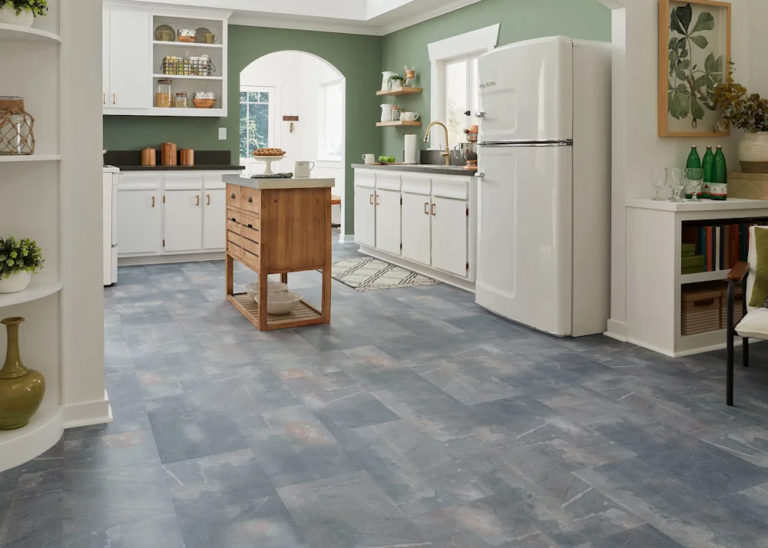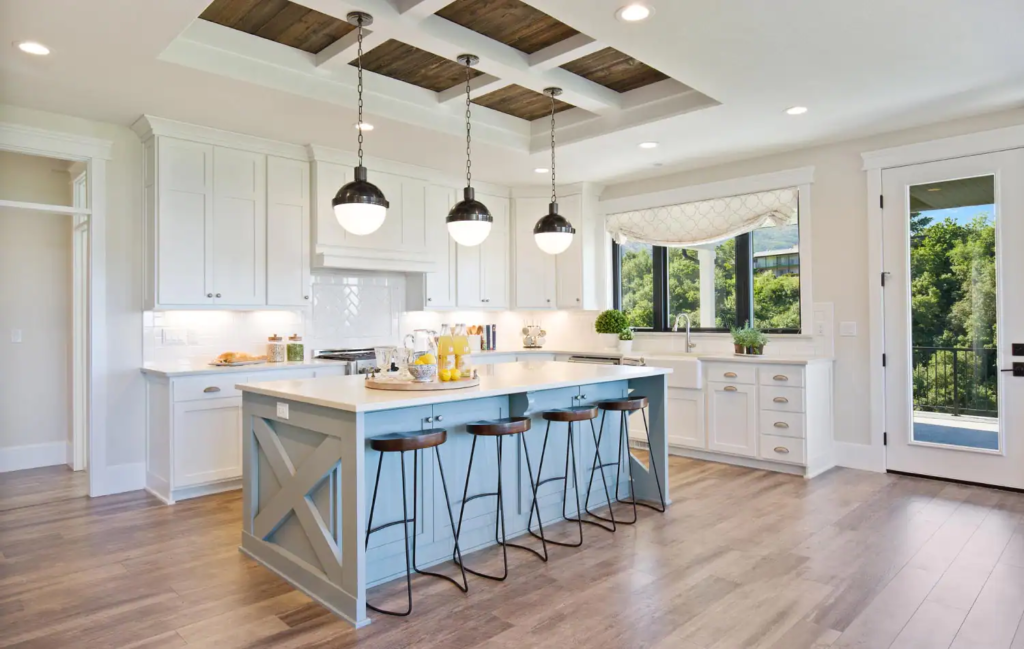“What is the trend in kitchen flooring in 2024?” When it comes to interior design, the kitchen is the center of the house, and the flooring in it provides the structure for both its appearance and use. As 2024 approaches, kitchen flooring trends are still developing and providing homeowners with creative options that combine durability, style, and utility. Come explore the newest trends in kitchen flooring for 2024 with us.
Table of Contents
Eco-Friendly Materials Take Center Stage
Sustainable flooring materials have become more and more popular as eco-conscious living and sustainability are prioritized more and more. We see an increase in the usage of cork, bamboo, and reclaimed wood flooring options in 2024. Homeowners who care about the environment like to use these materials since they not only provide the kitchen a hint of warmth from nature but also lessen their environmental impact.
Vibrant Colors and Designs Declare Yourself
The days of boring kitchen floors are long gone. Homeowners are embracing vivid colors and strong patterns in their kitchen spaces in 2024 to add flair and personality. Eye-catching patterns that function as focus points in contemporary kitchens are becoming more and more popular. These patterns can range from geometric shapes to complex motifs. Furthermore, striking color schemes like terracotta tones, emerald greens, and deep blues are being adopted to give kitchen floors a pop of drama.
Luxury Vinyl Flooring: An Elegant and Useful Option
“What is the trend in kitchen flooring in 2024?” According to this, Luxury vinyl stands out in the field of kitchen flooring thanks to its excellent blend of design, cost, and durability. In 2024, technological breakthroughs have taken luxury vinyl flooring to new heights, providing incredibly genuine, hyper-realistic wood and stone textures that replicate the appearance and feel of real materials. Additionally, because of its water resistance, it’s a great option for kitchens where spills and splashes are unavoidable.

The Classic Beauty of Porcelain and Ceramic Tiles
“What is the trend in kitchen flooring in 2024?” According to this, because of their classic beauty and extended lifespan, ceramic and porcelain tiles have long been preferred, and in 2024, they will still be the industry leaders in kitchen flooring. These adaptable materials provide a broad range of design possibilities, from contemporary and sleek to rustic and traditional. Thanks to developments in digital printing technology, homeowners can now customize their kitchen areas with an infinite array of patterns, textures, and finishes for ceramic and porcelain tiles. This allows homeowners to let their creativity run wild.

Timeless Hardwood: Traditional Charm with Contemporary Infusions
“What is the trend in kitchen flooring in 2024?” According to this, even if modern materials are the dominant trend in kitchen flooring, hardwood still has an unmatched timeless appeal. Hardwood flooring has a comeback in 2024, with an emphasis on creative finishes and sustainable sourcing. Traditional hardwood flooring is given a contemporary makeover by wide-plank designs, matte finishes, and exotic wood species, which guarantee endurance and durability while adding warmth and character to the kitchen.

Innovative Technology: Intelligent Flooring Options for Today’s Kitchen
“What is the trend in kitchen flooring in 2024?” When it comes to kitchen flooring, innovation meets functionality; the introduction of smart flooring options has completely changed the way we use our living areas. By 2024, smart flooring will be a seamless part of the kitchen, providing a plethora of capabilities that will improve energy efficiency, safety, and convenience.
By detecting spills or leaks, sensor-embedded flooring minimizes possible water damage by sending alerts to homeowners’ smartphones so they may take quick action. Moreover, underfloor heating is provided by integrated heating components, which lowers energy usage and guarantees maximum comfort during the winter.
Solutions for Hybrid Flooring in the Modern House
“What is the trend in kitchen flooring in 2024?” Hybrid flooring has become a game-changer in 2024 as homeowners look for flooring alternatives that offer the ideal blend of elegance and utility. Hybrid flooring, which combines the greatest qualities of vinyl and laminate, provides the realistic appearance of hardwood with the water resistance of vinyl, making it a great option for kitchens where humidity and moisture are issues. Its creative design guarantees longevity and little care, making it a useful and fashionable flooring option for the contemporary house.
Smooth Integration of Intelligent Technology
The incorporation of smart technology into kitchen flooring has gained traction in 2024, coinciding with the growing trend of smart houses. Imagine entering your kitchen and finding that the floor recognizes you and modifies the temperature appropriately. Thanks to developments in wireless charging tiles and heated flooring systems, homeowners may now experience the ease of having technology incorporated into their kitchen floors. These cutting-edge innovations give the area a genuinely futuristic feel while also adding a luxurious touch and improving overall functionality.
Stressing Dimension and Texture
The visual appeal of kitchen floors can be greatly enhanced by texture, and in 2024, textured materials that give the room depth and dimension will once again be in style. Textured flooring alternatives, such as hand-scraped finishes and embossed patterns, are becoming more popular because of their capacity to add both tactile appeal and visual intrigue. Incorporating mosaic tiles or wood with metal accents are two examples of integrating mixed materials that offer another depth of texture, giving homeowners the ability to create visually attractive and incredibly appealing kitchen floors.
Green Innovations in Underlayment for Flooring
Although the surface material of kitchen flooring receives most of the attention, underlayment is just as important. The market for environmentally friendly underlayment solutions that go well with sustainable flooring materials is expected to rise by 2024. Because they may minimize environmental impact while providing sound insulation, moisture protection, and thermal efficiency, recycled rubber and cork underlayment are becoming increasingly attractive options. Homeowners may lessen their carbon footprint and improve the longevity and function of their kitchen floors by choosing eco-friendly underlayments.
Resilience and Extended Life in Busy Areas
Frequently the busiest room in the house, the kitchen is prone to wear and tear from frequent foot activity. Longevity and resilience are still crucial factors to take into account in 2024 when selecting kitchen flooring materials. Because they can endure daily wear and tear while still looking good, resilient flooring solutions including SPC (Stone Plastic Composite) and WPC (Wood Plastic Composite) flooring, porcelain tile, and engineered hardwood are preferred. These long-lasting flooring solutions guarantee that your kitchen will continue to look gorgeous for many years to come with the right upkeep and care.
Conclusion: What is the trend in kitchen flooring in 2024?
The kitchen flooring trends for 2024 exhibit a tasteful fusion of elegance, sustainability, and innovation. When it comes to turning their kitchen flooring into breathtaking pieces of art, homeowners have an abundance of options, ranging from eco-friendly materials to striking patterns and useful hybrid solutions. Every taste and lifestyle can be satisfied with a different type of flooring, be it the contemporary appeal of luxury vinyl or the classic elegance of ceramic tiles. Therefore, instead of settling for ordinary, use the newest flooring trends to transform your kitchen into something extraordinary.




























